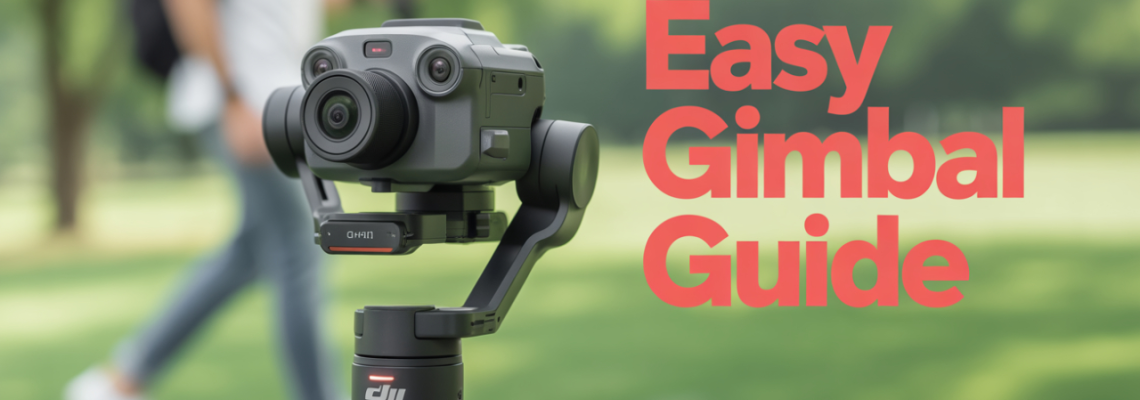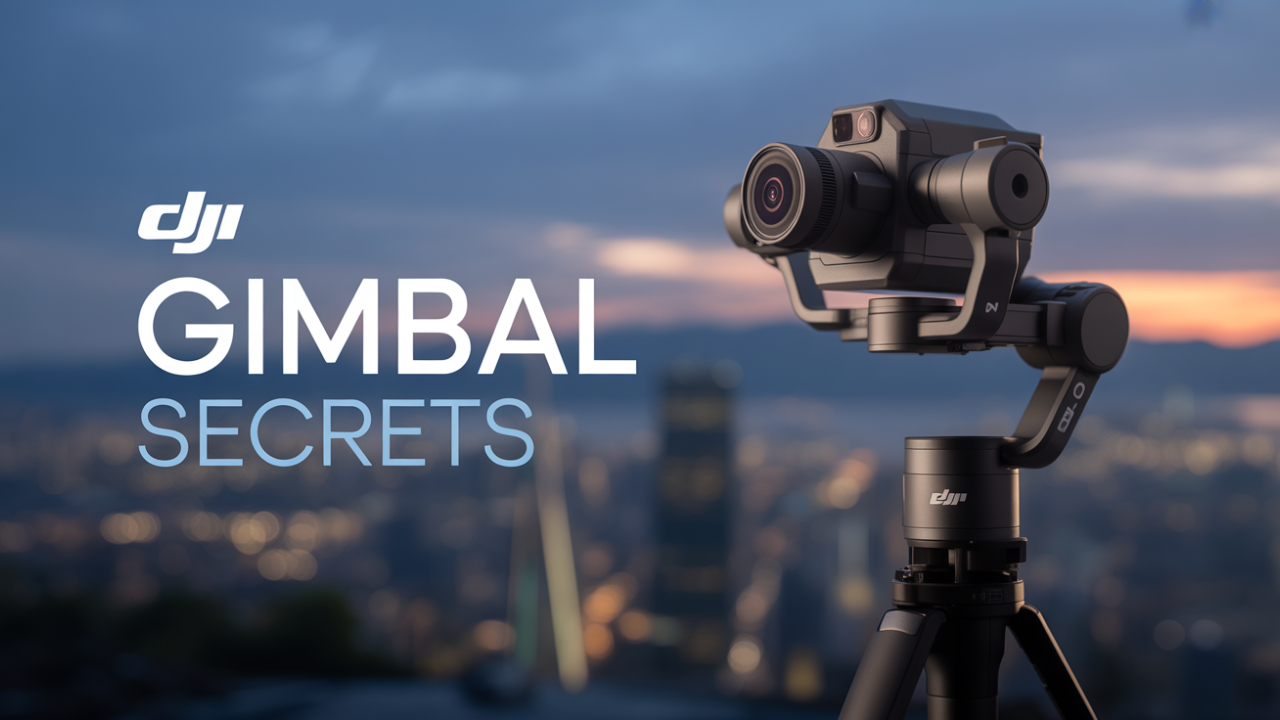

The beginner guide to using DJI gimbal begins here. Whether someone is brand new to gimbals or wants to improve their skills, this post will walk through how to balance a DJI gimbal, DJI gimbal setup for smartphones, how to calibrate DJI gimbal step by step, DJI gimbal settings for smooth video, how to connect DJI gimbal to phone, DJI Osmo gimbal tutorial for beginners, how to stabilize video with DJI gimbal, DJI gimbal modes explained, how to use DJI gimbal for vlogging, best tips for shooting with DJI gimbal, common DJI gimbal problems and solutions, how to charge DJI gimbal battery, how to update DJI gimbal firmware, and how to use DJI gimbal with DSLR camera.
Geonline brings this guide grounded in hands-on experience and best practices. The aim is to help beginners become confident creators using a DJI gimbal.
Why This Guide Matters
People often buy a gimbal and struggle with shaky footage, weird jitters, or confusing menus. This guide solves those pain points. By the end, a newbie can set up and use a DJI gimbal to shoot smooth video, vlog, and avoid common mistakes.
Getting Started — What Is a DJI Gimbal and Why Use It
A DJI gimbal is a motorized stabilization system that counteracts your hand movement and camera shake. It enables smooth, cinematic motion even when walking, panning, or running.
From my first day using one, I saw how shaky handheld footage turned into buttery fluid shots. That convinced me how powerful a gimbal can be.
Key reasons to use a DJI gimbal:
Removes unwanted jitter and shake
Allows fluid pans, tilts, and tracking movement
Supports creative modes (time-lapse, follow, FPV)
Works with phones, action cams, and even DSLR / mirrorless systems
DJI Gimbal Setup for Smartphones
One of the most popular use cases is for smartphone filming — vlogging, travel, TikTok, and social content.
What You’ll Need
DJI gimbal compatible with phones (e.g. DJI Osmo Mobile series)
A recent smartphone
USB cable (for power / control)
DJI companion app (install on your phone)
Step-by-Step Setup
Mount the phone on the gimbal clamp.
Balance the phone — slide it left/right, tilt forward/back until it holds still in neutral position (see next section).
Power on the gimbal by pressing and holding the power button.
Connect to app — open the DJI app; the gimbal should pair automatically via Bluetooth or Wi-Fi.
Fine tune in app — set calibration, orientation, and enable settings like “pan follow” or “FPV.”
Test motion — move the gimbal across axes and see if the motors respond smoothly.
Once setup is complete, the beginner can explore shooting modes.
How to Balance a DJI Gimbal
Balancing is fundamental. If unbalanced, motors strain, battery life suffers, and video may jitter.
Why Balance Matters
Extends motor life
Improves smoothness and reduces micro jitters
Saves battery
Prevents motor overload errors
Step-by-Step Balancing Guide
Axis 1: Tilt axis
Tilt the camera or phone downwards
Adjust the tilt arm forward/back so the phone stays horizontal without motors
Axis 2: Roll axis
Adjust side-to-side balance
Slide the phone left or right until it stays level
Axis 3: Pan axis (yaw)
Hold the gimbal upright
Rotate the arm so the phone faces forward and remains stable
At each stage, test by turning off motors and seeing if the device holds its position. It should not drift or swing.
Also, many DJI apps offer auto calibration to fine-tune balance after rough manual balancing.
How to Calibrate DJI Gimbal Step by Step
Calibration ensures the sensors and motors are properly aligned.
Power on the gimbal and place it on a level surface.
In the DJI app, locate Gimbal Calibration (or Auto Calibration) in settings.
Start calibration — the gimbal will sweep axes.
Wait until the process finishes and displays “successful.”
If errors occur, repeat or adjust manual balancing.
Calibration should be done:
After firmware updates
When balance changes (new lens, heavier battery, added accessories)
If you see small jitters in footage
DJI Gimbal Settings for Smooth Video
Choosing the right settings is key for buttery footage.
Motor Strength / Balance Settings
Set motor strength to auto or balanced, not “stronger than needed.” Overdriving causes noise and jitter.
Movement Modes & Speed
Follow Speed – how fast the gimbal catches up to your motion
Pitch / Roll / Yaw Sensitivity – lower sensitivity for smoother motion
SmoothTrack and Motion Curve
Enable SmoothTrack and adjust the motion curve (slow-fast transition) so the camera eases into movement rather than snapping.
Dead Band / Dead Zone
Set a dead zone so minor unwanted wrist shake doesn’t trigger gimbal movement.
Orientation & Compass Settings
Set orientation (portrait vs landscape) and check compass interference if using GPS modes.
How to Connect DJI Gimbal to Phone
Connecting ensures control, firmware updates, and remote shooting.
Bluetooth / App Connection
Turn on Bluetooth on phone
Open DJI app
The gimbal should auto-pair
If not, manually search devices
Wired Connection Mode
Some gimbals support USB-to-phone cables. This enables the gimbal to control phone camera shutter and zoom.
Permissions & App Setup
Grant camera and mic permissions in the DJI app. Also enable the "USB debugging" or “accessory mode” if required by the phone OS.
DJI Osmo Gimbal Tutorial for Beginners
This section walks a newbie through shooting simple video using DJI Osmo gimbal.
Mount phone or camera and balance.
Power on and calibrate.
Select Pan Follow mode.
Practice slow pan left to right.
Try Follow mode — rotate gimbal in all axes.
Use FPV / Sport modes for motion or action shots.
Use Timed Shots / Time-lapse mode: move slowly or let gimbal move slowly while shooting long exposures.
From personal experience, starting with simple pans and walks built confidence gradually before advanced modes.
How to Stabilize Video with DJI Gimbal
Stabilization is not just hardware — technique matters.
Shooting Techniques
Walk smoothly (roll feet heel-toe)
Use both hands and rest elbows
Keep the gimbal low to reduce leverage
Avoid sudden direction changes
Use the Right Mode
Follow mode for walking
FPV mode for immersive shots
Lock mode when fixed framing is needed
Motion Planning
Plan your moves slowly and steadily. Use slow dolly and slider motion instead of jerky steps.
DJI Gimbal Modes Explained
Understanding modes is key to creative control.
You can quickly switch modes via physical buttons or device app.
How to Use DJI Gimbal for Vlogging
Vlogging often demands you hold the camera and talk.
Recommended Mode
Use Follow mode typically, so tilt is smooth but yaw follows your movement.
Use Selfie / Front Camera
Mount the phone facing you, use face tracking or subject tracking mode in the DJI app.
Movement & Framing
Walk slowly, keep the camera at eye level, and use shallow movement — avoid big swings.
Cut-ins and Transitions
Use gimbal movements for transitions: tilt up/down or pan between scenes for seamless cuts.
Best Tips for Shooting with DJI Gimbal
Always balance well — even small imbalance degrades footage
Use slow, deliberate movements
Use motion presets (panoramic, time-lapse)
Keep firmware up to date
Use an ND filter in bright light to allow lower shutter speeds
Test modes before important shoots
Practice walking techniques to reduce bobbing
Common DJI Gimbal Problems and Solutions
Gimbal Shakes or Vibrations
Cause: Imbalance or overload
Solution: Rebalance or lighten payload
Calibration Failure
Cause: Uneven surface or magnetic interference
Solution: Place gimbal on level surface, move away from metal / speakers
Motors Overloaded / Error Message
Cause: Payload too heavy or misbalance
Solution: Reduce load, adjust balance
Connection Lost Between Gimbal & Phone
Cause: Bluetooth interference or app bugs
Solution: Reset Bluetooth, re-pair or restart app
Battery Drains Too Fast
Cause: Overdriving motors or imbalanced load
Solution: Balance better or reduce motor strength
How to Charge DJI Gimbal Battery
Use original USB-C or USB adapter
Charge fully before first use
Avoid overcharging
Store at ~50% if unused for long periods
How to Update DJI Gimbal Firmware
Firmware updates often improve stability and fix bugs.
Open DJI app
Connect the gimbal
Go to Firmware Update section
Download the latest version
Install — keep gimbal powered and do not disconnect
After updates, you should recalibrate and rebalance to ensure stability.
How to Use DJI Gimbal with DSLR Camera
Using a heavier body like DSLR or mirrorless is trickier.
Choose the Right Gimbal
Pick a model rated for heavier payloads (check specs).
Balance Carefully
Add counterweights or plate extensions. The balance is more critical due to weight.
Fine-Tune Motor Settings
Increase motor strength just enough; don’t overdrive.
Use Lenses and Accessories Smartly
Avoid heavy zooms or add-on accessories unless needed.
Mobility Considerations
Use a lightweight setup for practical movement. Avoid switching lenses mid-shoot.
People Also Ask (FAQ)
Q: How do you balance a DJI gimbal for the first time?
A: Balance each axis manually by sliding and tilting the camera until it holds steady with motors off, then fine-tune in the DJI app.
Q: Can you use DJI gimbal with iPhone and Android phones?
A: Yes, DJI gimbals support both via Bluetooth or USB connection and the companion DJI app.
Q: Why is my DJI gimbal shaky even after balancing?
A: Possible causes: micro-vibrations due to loose mounting, weak motor strength, or poor calibration. Rebalance, recalibrate, and tighten mounting.
Q: Which gimbal mode is best for walking scenes?
A: Follow mode is ideal — it keeps pitch smooth while yaw follows your heading.
Q: Do I need to update DJI gimbal firmware?
A: Yes, updates provide bug fixes and feature enhancements — always update, then recalibrate.
Q: How often should I calibrate the gimbal?
A: After firmware updates, after adding new accessories, or when you detect jitter in footage.
Q: Can a DJI gimbal support a DSLR camera?
A: Yes, if the gimbal is rated for heavier payload — balance and motor strength must be optimized.
Final Thoughts
This beginner guide to using DJI gimbal has walked through every critical step. From how to balance a DJI gimbal to DJI gimbal setup for smartphones, how to calibrate DJI gimbal step by step, DJI gimbal settings for smooth video, how to connect DJI gimbal to phone, DJI Osmo gimbal tutorial for beginners, how to stabilize video with DJI gimbal, DJI gimbal modes explained, how to use DJI gimbal for vlogging, best tips for shooting with DJI gimbal, common DJI gimbal problems and solutions, how to charge DJI gimbal battery, how to update DJI gimbal firmware, and how to use DJI gimbal with DSLR camera — you now have a full roadmap.



Leave a Comment